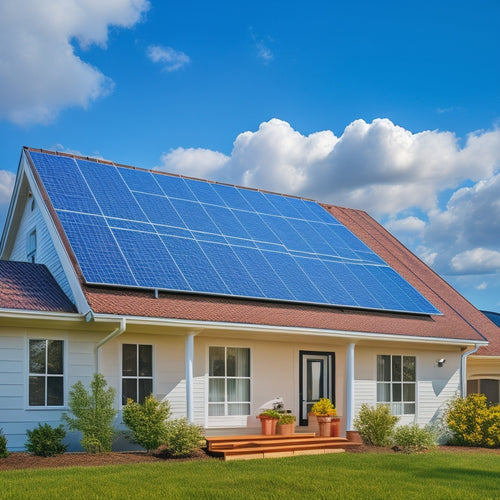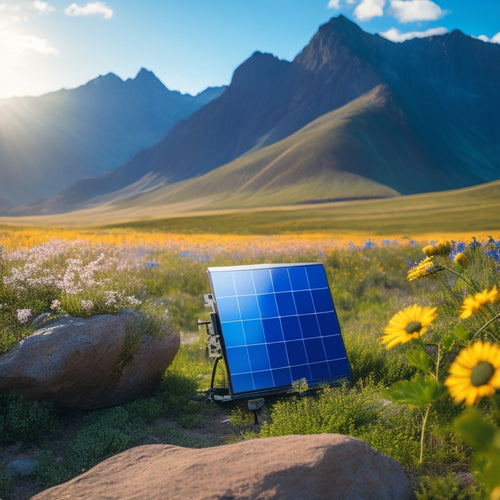
Rural Solar Power Systems
Share
You're considering rural solar power systems, a reliable way to guarantee zero energy bills and achieve renewable energy independence, allowing you to produce as much energy as you consume and greatly reduce your carbon footprint. With a well-designed system, you can achieve net zero energy status, storing excess energy generated during the day for nighttime use. To get started, assess your daily energy demands, considering energy-intensive appliances, and determine the right solar panel array size and deep cycle battery technology for your needs. As you investigate the possibilities, you'll uncover more ways to optimize your system for energy independence and sustainability.
The Essentials
- Rural solar power systems provide energy independence and cost savings by eliminating monthly energy bills and reducing reliance on the grid.
- Achieving net zero energy through solar power systems significantly lowers carbon footprint and greenhouse gas emissions, supporting a cleaner environment.
- Properly sized and managed energy storage solutions, such as deep cycle batteries, are crucial for optimizing renewable energy and ensuring a steady supply of electricity.
- Accurate calculations of daily energy usage and power requirements are essential for designing an efficient rural solar power system that meets energy needs.
- High-efficiency inverters and solar panels are vital for maximizing energy harvest and reducing energy losses, ensuring a reliable and sustainable energy source.
Zero Energy Bills Guaranteed
With a rural solar power system, you'll enjoy zero energy bills guaranteed, which translates to no monthly expenses for you.
By leveraging renewable energy independence and utilizing the power of the sun, you'll reduce your reliance on the grid and eliminate your energy expenses altogether.
This means you'll produce as much energy as you consume, achieving a net zero energy status.
No Monthly Expenses
Most rural homeowners who invest in solar power systems reap a significant benefit: no monthly expenses for their energy needs.
You'll enjoy the freedom of producing your own clean energy, reducing your reliance on the grid and eliminating your energy bills. With a solar power system, you'll be generating electricity on your own terms, giving you true energy independence. By embracing renewable energy with self-sufficient power solutions Off Grid Solar, you'll be part of a growing movement towards sustainable living.
Additionally, you'll have control over your energy costs, knowing exactly how much you'll pay each month - zero. This is especially beneficial for rural homeowners who may have limited access to traditional energy sources.
With a solar power system, you'll be producing energy during the day and storing excess energy in a battery for nighttime use.
This means you'll have a steady supply of electricity, even when the sun isn't shining. You'll be energy-independent, free from the constraints of traditional energy providers, and enjoying the peace of mind that comes with knowing you're generating your own clean energy.
Net Zero Energy
You've eliminated monthly energy bills, now it's time to take the next step: achieving net zero energy. This means your rural solar power system produces as much energy as you consume, making you entirely self-sufficient. With net zero energy, you're not only saving money but also reducing your carbon footprint.
To reach net zero energy, you need to balance your energy production and consumption. Here's a breakdown of the key factors to take into account:
| Factor | Description | Impact |
|---|---|---|
| Energy Efficiency | Improving your home's insulation, windows, and lighting | Reduces energy consumption |
| Solar Panel Size | Increasing the size of your solar panel array | Increases energy production |
| Energy Storage | Adding a battery storage system to store excess energy | Allows for energy independence during outages |
| Rural Electrification | Connecting to the grid or using a microgrid for energy backup | Guarantees reliable energy supply |
Reduced Carbon Footprint Guaranteed
You'll greatly reduce your carbon footprint by switching to a rural solar power system, which generates low-emissions energy and enables carbon-neutral living.
With solar power, you'll produce clean energy on-site, minimizing your reliance on fossil fuels and lowering your greenhouse gas emissions.
Residential solar power systems, which employ photovoltaic cells to convert sunlight into electricity, can be easily integrated into your home.
Low Emissions Energy
Rural solar power systems employ the sun's energy to generate electricity, effectively minimizing your reliance on fossil fuels and slashing carbon emissions in the process. By utilizing this renewable energy source, you'll be contributing to a cleaner environment and reducing your carbon footprint.
This is particularly beneficial for sustainable farming practices, as it allows you to power your operations without compromising the land or air quality.
With energy independence comes a sense of freedom, and rural solar power systems offer just that. You'll no longer be tied to the grid, and with solar incentives, you may even be able to sell excess energy back to the utility company.
Community engagement is also encouraged, as neighbors can share knowledge and resources to optimize their systems. The environmental impact is significant, with reduced emissions and a decreased reliance on finite resources.
Advances in technology have improved grid reliability, and cost savings are substantial. With policy support and energy storage solutions, you can rest assured that your investment in rural solar power will pay off in the long run.
Carbon Neutral Living
By utilizing the power of solar energy, rural residents can greatly reduce their carbon footprint and make a tangible impact on the environment.
You can take control of your energy production and consumption, ensuring a reduced reliance on fossil fuels and a cleaner energy future.
When you opt for a rural solar power system, you're not only generating clean energy but also reducing your dependence on the grid.
This means you'll be producing fewer greenhouse gas emissions, which contribute to climate change.
Additionally, solar panels are made from eco-friendly materials, ensuring a sustainable energy solution from start to finish.
Deep Cycle Battery Technology
When selecting deep cycle batteries for your rural solar power system, you'll want to take into account three key factors: battery life expectancy, cycle depth, and health.
To maximize renewable energy storage and reduce reliance on the grid, it's crucial to choose high-performance batteries that can handle the demands of your solar power system solar battery system.
Your battery's life expectancy will depend on the number of charge cycles it can handle, while cycle depth refers to the percentage of the battery's capacity that's being used.
Battery Life Expectancy
Deep cycle batteries, the heart of your rural solar power system, rely on advanced technology to store excess energy generated by your solar panels during the day for use at night or during power outages. An essential aspect of your system's reliability is the battery life expectancy, which depends on various factors, including the type of battery, usage patterns, and maintenance practices.
Proper battery maintenance is vital to extending the life of your deep cycle batteries. Regular checks on water levels, cleaning of terminals, and ensuring the batteries are charged correctly can greatly impact their lifespan. Solar efficiency also plays a role in battery life, as a well-designed solar array can help reduce the depth of discharge, thereby increasing the battery's lifespan.
| Battery Type | Average Lifespan | Ideal Applications |
|---|---|---|
| Flooded Lead-Acid | 5-7 years | Small-scale off-grid systems |
| AGM (Absorbed Glass Mat) | 7-10 years | Medium-scale off-grid systems |
| Lithium-Ion | 10-15 years | Large-scale off-grid systems, high-reliability applications |
Cycle Depth and Health
Operating within a specific cycle depth is crucial for maintaining the health of your deep cycle batteries. Cycle depth refers to the percentage of a battery's capacity that's discharged before recharging.
You'll want to avoid deep discharging, which can shorten your battery's lifespan. Instead, aim for a moderate cycle depth of around 50% to guarantee ideal energy storage and battery maintenance.
As you manage your rural solar power system, keep in mind that frequent shallow discharges can also impact your battery's health.
It's important to strike a balance between energy storage and battery maintenance. You'll want to monitor your battery's state of charge and adjust your energy usage accordingly.
Assess Your Energy Demands
You'll need to calculate your daily energy usage to determine the total power requirements for your rural solar power system. This involves identifying the appliances and devices you'll be powering, their wattage, and the number of hours they'll be in use each day.
When selecting a solar battery, consider options like Renogy's deep cycle batteries that are designed for off-grid energy storage.
Daily Energy Usage
About 30 kilowatt-hours (kWh) of electricity per day is a typical energy usage for an average rural household. This consumption pattern will vary depending on your specific needs and appliances.
You'll want to assess your daily energy usage to determine the size of the solar power system you'll need. Start by identifying your energy-intensive appliances, such as refrigerators, freezers, and water pumps. Calculate their individual energy consumption patterns to get an accurate total.
Consider your lighting needs, including indoor and outdoor lighting. Don't forget about your electronic devices, like computers, TVs, and smartphones.
You may also have rural energy sources like well pumps, septic systems, or farm equipment that require electricity. Make a list of all these devices and their respective energy consumption rates.
This information will help you determine your total daily energy usage, which is essential for designing an efficient solar power system that meets your needs and provides the freedom you desire.
Total Power Requirements
Now that you've calculated your daily energy usage, it's time to evaluate your total power requirements. This involves determining the size of the solar panel array and energy storage system you need to fulfill your energy demands.
To do this, you'll need to take into account the peak sun hours in your area, the efficiency of your solar panel types, and the depth of discharge of your energy storage system.
You'll want to verify your solar panel array can produce enough power to recharge your energy storage system during the day, while also meeting your energy demands at night or during periods of low sunlight.
A general rule of thumb is to oversize your solar panel array by 10-20% to account for any energy losses due to panel efficiency, wiring, and other factors.
Higher Inverter Efficiency Ratings
When selecting an inverter for your rural solar power system, you'll want to prioritize higher efficiency ratings to maximize your energy harvest.
With a more efficient inverter, you can expect higher power output, which translates to greater energy yield and reduced energy losses.
Higher Power Output
Optimizing your rural solar power system's performance relies heavily on maximizing its power output, which is largely dependent on the inverter's efficiency rating. You want to guarantee that your system is producing the most power possible to meet your energy needs.
To achieve higher power output, you'll need to evaluate inverters with high efficiency ratings. These inverters can convert more of the DC power from your solar panels into usable AC power for your home or business. This is especially important if you're relying on energy storage solutions to power your property during the night or on cloudy days.
Here's a comparison of inverter efficiency ratings and their impact on power output:
| Inverter Efficiency Rating | Power Output Increase |
|---|---|
| 95% | 5% |
| 97% | 10% |
| 99% | 15% |
| 99.5% | 20% |
As you can see, even a small increase in inverter efficiency can lead to a significant enhancement in power output. When combined with high solar panel efficiency, you'll be generating more power than ever before.
Frequently Asked Questions
Can Rural Solar Power Systems Be Connected to the Grid?
You can connect your solar power system to the grid, achieving grid integration and energy independence, allowing you to sell excess energy back to the utility company and enjoy reduced electricity bills, while still having the freedom to disconnect when desired.
Are Solar Panel Warranties Transferable to New Owners?
Like a ray of sunshine, you're wondering about warranty coverage; rest assured, most solar panel warranties are transferable to new owners, providing a seamless ownership transfer, giving you peace of mind and freedom from worry.
Do Rural Solar Power Systems Require Regular Maintenance?
You'll want to know that solar power systems, in general, require regular maintenance to guarantee system longevity and minimize maintenance costs; by doing so, you'll maximize energy output and enjoy years of reliable, hassle-free power.
Can I Monitor My System's Performance Remotely?
"Out of sight, out of mind" doesn't apply here. You can keep a close eye on your system's performance from anywhere, using remote monitoring and advanced performance analytics to track its efficiency and make data-driven decisions.
Are Rural Solar Power Systems Susceptible to Cyber Attacks?
You're right to worry about cyber threats; any connected device is vulnerable. Implementing strong cybersecurity measures is essential to protect against attack vectors, ensuring your rural solar power system remains secure and your energy independence isn't compromised.
Final Thoughts
By utilizing the power of rural solar energy, you'll bask in the benefits of a burden-free budget and a clear conscience. Our state-of-the-art systems slash your carbon footprint and guarantee zero energy bills, thanks to deep cycle battery technology and precise assessments of your energy demands. With higher inverter efficiency ratings, you'll maximize your energy harvest and minimize your ecological impact. Seamlessly switch to a sustainable future, and savor the serenity of a self-sufficient lifestyle.
Related Posts
-

Cost of Solar Panel Installation
You can expect to pay between $15,000 and $30,000 or more for a typical solar panel installation, depending on the sy...
-

High-Efficiency Solar Battery Chargers for Remote Areas
High-efficiency solar battery chargers are essential for your off-grid energy needs in remote areas. They maximize en...
-

Top Solar Powered Camping Fans for Camping Enthusiasts
If you're a camping enthusiast, a solar-powered fan can be a transformative element for your outdoor experience. Thes...


